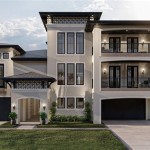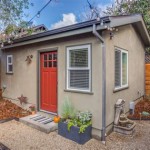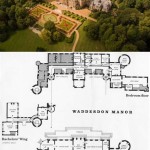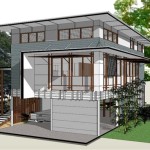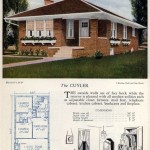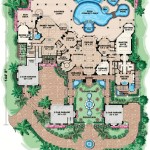Two-Story House Plans for Small Lots: Maximizing Space and Efficiency
The increasing demand for housing in urban areas, coupled with rising land costs, has led to a surge in the popularity of small lot developments. Building on small lots presents unique challenges, requiring innovative architectural designs that effectively utilize limited space. Two-story house plans offer an optimal solution, allowing homeowners to maximize living area without expanding the building's footprint. Understanding the nuances of designing and constructing a two-story home on a small lot is crucial for achieving a functional, aesthetically pleasing, and structurally sound residence.
Two-story construction inherently provides a greater floor area compared to a single-story design on the same lot size. This vertical expansion opens up possibilities for incorporating more rooms, larger living spaces, and features that would otherwise be impractical. The strategic placement of living areas, bedrooms, and utilitarian spaces across two levels can create a more fluid and organized flow within the home. Furthermore, a well-designed two-story house can significantly enhance the curb appeal and overall value of a property, making it a worthwhile investment for homeowners.
Key Considerations in Two-Story House Plans for Small Lots
Successfully implementing a two-story house plan on a small lot necessitates careful consideration of various design and construction factors. These considerations encompass site analysis, structural integrity, spatial planning, and adherence to local building codes and regulations. Overlooking any of these aspects can result in design flaws, structural vulnerabilities, and potential setbacks during the construction process.
Site Analysis and Lot Characteristics: Before embarking on any design work, a thorough site analysis is paramount. This involves evaluating the lot's dimensions, topography, soil conditions, and orientation. The shape of the lot, whether rectangular, square, or irregular, will directly influence the layout of the house. Steep slopes may require specialized foundation systems and retaining walls, adding to the construction cost. Soil composition affects the foundation design and the need for soil stabilization measures. The orientation of the lot, particularly concerning sun exposure, will impact the placement of windows and the overall energy efficiency of the house.
Additionally, it is critical to assess the surrounding environment. Existing trees, neighboring buildings, and easements can all impose constraints on the building design. Setback requirements, which dictate the minimum distance a building must be from property lines, are strictly enforced by local authorities. Compliance with these regulations is essential to avoid legal issues and potential redesigns later on.
Structural Design and Foundation: The structural integrity of a two-story house is of utmost importance, especially on a small lot where space for maneuverability during construction may be limited. The foundation must be designed to adequately support the weight of the structure and resist soil movement. Common foundation types include slab-on-grade, crawl spaces, and basements. The choice of foundation will depend on soil conditions, climate, and the homeowner's preferences. A structural engineer should be consulted to ensure the foundation and framing system are designed to withstand the anticipated loads and environmental stresses.
The framing system, which forms the skeleton of the house, must be carefully engineered to provide adequate support for the upper floor and roof. Load-bearing walls, beams, and columns should be strategically placed to distribute weight evenly. The use of engineered wood products, such as laminated veneer lumber (LVL) and oriented strand board (OSB), can enhance the strength and stability of the framing system. Connections between structural elements must be properly designed and executed to prevent failures.
Spatial Planning and Functional Layout: Effective spatial planning is crucial for maximizing the usability of a small lot two-story house. The layout should prioritize functionality, comfort, and efficient circulation. Open-concept living areas can create a sense of spaciousness and improve natural light penetration. Strategic placement of windows and skylights can further enhance the feeling of openness.
Consider the placement of bedrooms and bathrooms to ensure privacy and minimize noise transmission. Master suites are often located on the upper floor, providing a quiet retreat. The location of the staircase is also important, as it can significantly impact the flow of traffic within the house. A well-designed staircase should be both functional and aesthetically pleasing, potentially serving as a focal point in the home. Utilizing vertical space for storage is another effective strategy for maximizing space. Built-in shelves, cabinets, and closets can provide ample storage without encroaching on valuable floor area.
Design Strategies for Small Lot Two-Story Homes
Several design strategies can be employed to optimize space and enhance livability in two-story homes built on small lots. These strategies focus on maximizing natural light, minimizing wasted space, and creating a sense of openness. Incorporating these elements into the design can transform a compact dwelling into a comfortable and inviting home.
Verticality and Compact Footprint: The primary advantage of a two-story design is its ability to maximize living space on a small lot by expanding vertically. This necessitates a carefully planned footprint that optimizes the use of available land. Narrow and deep lot configurations, for example, may require a long and rectangular house design. Corner lots offer more flexibility in terms of orientation and layout. The goal is to create a compact and efficient footprint that minimizes wasted space and maximizes the usable floor area on both levels.
Open Floor Plans and Flexible Spaces: Open floor plans, which combine living, dining, and kitchen areas into a single, flowing space, can create a sense of spaciousness and improve natural light circulation. The absence of interior walls allows for greater flexibility in furniture arrangement and utilization of space. Flexible spaces, such as rooms that can serve multiple purposes, are also valuable in small lot homes. A guest room that can double as a home office or a dining room that can be converted into a playroom can significantly enhance the functionality of the house.
Natural Light and Ventilation: Maximizing natural light and ventilation is crucial for creating a comfortable and healthy living environment in a small lot home. Large windows, strategically placed to capture sunlight, can brighten interior spaces and reduce the need for artificial lighting. Skylights can provide additional natural light, especially in areas that are not directly exposed to sunlight. Proper ventilation is essential for maintaining air quality and preventing moisture buildup. Cross-ventilation, achieved by placing windows on opposite sides of the house, can promote airflow and reduce the need for air conditioning.
Outdoor Living Spaces: In small lot homes, outdoor living spaces can serve as an extension of the interior living area, providing additional space for relaxation, entertainment, and recreation. Decks, patios, and balconies can be incorporated into the design to create inviting outdoor spaces. Vertical gardens, which utilize wall space for planting, can add greenery and visual interest to outdoor areas. Careful landscaping can also enhance the privacy and aesthetic appeal of the property.
Specific Design Elements and Considerations
Beyond broad design strategies, several specific design elements can significantly impact the functionality and appeal of a two-story home on a small lot. These elements include staircase design, storage solutions, and material selection. Paying attention to these details can elevate the overall quality and livability of the house.
Staircase Design: The staircase is a critical element in a two-story house, both functionally and aesthetically. It should be designed to be safe, comfortable, and visually appealing. The location of the staircase can impact the flow of traffic and the overall layout of the house. A centrally located staircase can serve as a focal point, while a staircase tucked away in a corner can save space. The design of the staircase itself can also contribute to the overall aesthetic of the home. Open staircases, which lack risers, can create a sense of openness and allow more light to penetrate. Spiral staircases are a space-saving option, but they may not be suitable for all users.
Storage Solutions: In small lot homes, efficient storage solutions are essential. Built-in shelves, cabinets, and closets can maximize storage space without encroaching on valuable floor area. Under-stair storage, which utilizes the space beneath the staircase, is a particularly effective strategy. Loft spaces, which can be accessed by a ladder or a small staircase, can provide additional storage for infrequently used items. Consider incorporating vertical storage solutions, such as tall cabinets and shelves, to maximize the use of wall space.
Material Selection: The choice of materials can significantly impact the appearance, durability, and energy efficiency of a small lot home. Durable and low-maintenance materials are particularly important, as they can reduce the need for frequent repairs and replacements. Energy-efficient windows and insulation can help to reduce energy consumption and lower utility bills. Sustainable materials, such as bamboo flooring and recycled content countertops, can contribute to a more environmentally friendly home. The color palette should be chosen carefully to create a cohesive and visually appealing design. Light colors can make a space feel larger and brighter, while darker colors can create a sense of warmth and intimacy.
Designing a two-story house plan for a small lot is a complex undertaking that requires careful planning, attention to detail, and a thorough understanding of design principles. By considering the key factors outlined above and incorporating innovative design strategies, homeowners can create functional, aesthetically pleasing, and structurally sound residences that maximize the use of available space.

2 Story House Plans For Narrow Lots Blog Builderhouseplans Com

2 Story House Plans For Narrow Lots Blog Builderhouseplans Com

Narrow Lot Two Y House Plan With 4 Bedrooms Cool Concepts Plans

Simple Narrow Lot House Plans Houseplans Blog Com

Adorable Two Story House Plan For Narrow Lot 31566gf Architectural Designs Plans

Lincoln Small Lot And Narrow Block Home Design By Gw Homes House Plans Designs

2 Story Narrow Lot House Plans Under 40 Feet Drummond

Cool House Plans Offers A Unique Variety Of Professionally Designed Home With Floor By Narrow Lot Mini

2 Story House Plans For Narrow Lots Blog Builderhouseplans Com

Floor Plan Friday Narrow But Large 2 Y Home House Plans Designs Lot



